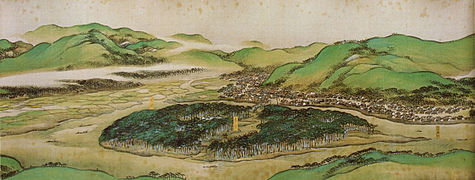Tani Buncho
Tani Bunchō ( Japanese 谷 文 晁), actually Tani Masayasu (谷 正 安) (born October 15, 1763 in Negishi , Shitaya , Edo ; † January 6, 1841 ) - he was called Tani Bungorō (谷 文 五郎) and used the stage name Shazanrō (冩 山 樓) and Gagakusai (画 学 斎) - was a painter and poet of the Edo period .
He was the eldest son of the famous Kanshi poet (漢詩, Kanshi , English "Chinese poetry") Tani Rokkoku.
At the time of his birth, his family had been in the service of the Tayasu clan for two generations , starting with the tax advice of Tani's grandfather, who saved the Tayasu from an economic disaster at the time and thus helped his family to make a secure living. The fame of the father paved the way for Buncho into the cultural circles of Edo and enabled him to build up a nationwide network.
Artistic career
He began his artistic training with Katō Bunrei, a master of the Kanō school . Then he worked for Watanabe Gentai, a master of the Chinese art of landscape painting of the "North School". The Nanga style (“southern school”) and the Japanese painting of the Yamato-e also had an influence on his work . His style of painting is therefore called namboku gappa (南北 合 派, "North-South Synthesis Style").
In 1788 Bunchō began his employment with the Tayasu family as the “artistic apprentice of the house” ( okuzuke minarai ). In 1792 he became a "personal follower" ( tsuke ) of the regent Matsudaira Sadanobu , with whom Bunchō not only had a work-related relationship, but also a friendly one. Sadanobu often sent Buncho on trips on which the painter could make important national contacts that were of great importance for his work (e.g. the artist meetings of the sake maker and painter in the Nanga style Kimura Kenkadō ).
In the face of impending conflicts with other countries (e.g. Russia, which wanted Japan to open up to free trade), the Shogun issued the order to review the defenses of the coastal regions. Sadanobu took this task personally in hand and was accompanied on the trip in 1793 by Tani Buncho, the "painting reporter", so that he could make as true to life images of landscapes as possible, with which possible defense strategies could be planned. This resulted in the work Kōyo tanshō zu (公 余 探 勝 図).
Many other landscapes were created from similar commissions. The painter mastered many styles and also used them in order to create realistic representations of what was seen with the eye. Of particular importance for its accuracy is yōfūga ( Malerei風 画), painting in the western style . He was able to suppress his individual style and distinguished himself as a good copier and restorer of historically important works. His existence was secured by his service under Daimyō Matsudaira Sadanobu.
Bunchō has also emerged as a writer of illustrated books. He summarized his studies of old masters in Gagakusai kagan zukō and Bunchō zatsurokuchō . Further studies by him are Honchō gasan , Gagaku sōsho , Nihon meizan zue and Shazanrō gahon .
Bunchō had numerous students whom he trained in his school (画 塾 写 山 楼, Gajuku shazanrō ) in Edo . The four most important Tani-Bunchō-mon shitetsu (谷 文 晁 四 哲) called were Watanabe Kazan , Tachihara Kyōsho , Tsubaki Chikuzan and Takaku Aigai . Also Tanomura Chikuden was a student Tanis.
According to reviews, Tanis' pictures lack enthusiasm despite his high technical level and deep artistic education. In his mature phase, Tani created portraits of a highly realistic style.
gallery
Individual evidence
- ↑ a b Tazawa Yutaka: Biographical Dictionary of Japanese Art . Kodansha International, 1981. ISBN 0-87011-488-3 .
- ↑ a b Eczacibaşi Sanat Ansiklopedisi (German: Ezacibaşi Kunstenzyklopädie ) Editor: Yem Yayin (Yapi-Endüstri Merkezi Yayinlari), page 1735, 3rd edition, 1997 ISBN 975-7438-54-5 (Turkish)
- ↑ a b Encyclopedia Britannica: Information on Tani (English)
- ^ Landscape in the style of the north school.
literature
- Timon Screech: The Shogun's Painted Culture. Fear and Creativity in the Japanese states 1760-1829 . London 2000
- Khanh Trinh: Representation of real places. The “true landscapes” of the “painting reporter” Tani Bunchô (1763-1840) . Bern 2003
- Kenji Moriya: The Japanese Painting . Wiesbaden 1953
- Doris Croissant: Japanese landscape painting. Scrolls from 17th to 19th centuries Century from the Linden Museum Stuttgart . Stuttgart 1987
- Frank Lewis Chance: Tani Bunchô and the School of Japanese Painting . University of Washington 1986
Web links
| personal data | |
|---|---|
| SURNAME | Tani, Buncho |
| ALTERNATIVE NAMES | 谷 文 晁 (Japanese); Tani Masayasu (real name); 谷 正 安 (Japanese, real name); Tani Bungorō (nickname); 谷 文 五郎 (Japanese, nickname) |
| BRIEF DESCRIPTION | Japanese painter and poet |
| DATE OF BIRTH | October 15, 1763 |
| PLACE OF BIRTH | Negishi , Shitaya , Edo |
| DATE OF DEATH | January 6, 1841 |





